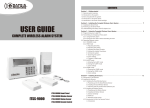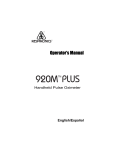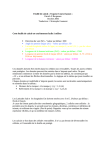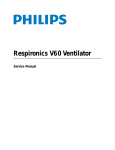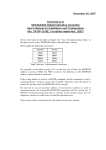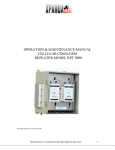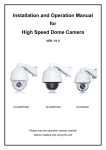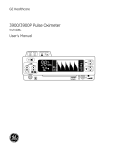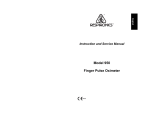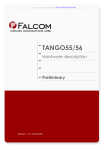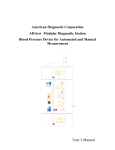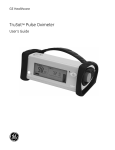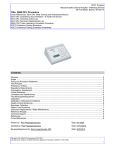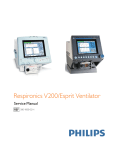Download 920M Pulse Oximeter - User Guide
Transcript
English Instruction and Service Manual Models 920 and 920M Hand Held Pulse Oximeters About the Manual Boxes draw attention to contraindications, warnings, and cautions. The information in this manual has been carefully checked and is believed to be accurate. In the interest of continued product development, RESPIRONICS, INC. reserves the right to make changes and improvements in this manual and the products it describes at any time, without notice or obligation. Caution: Federal Law (USA) restricts this device to sale by or on the order of a physician. Respironics Georgia 175 Chastain Meadows Court Kennesaw, Georgia 30144-3724 USA Customer Service Telephone: 1-800-345-6443 (USA and Canada) Customer Service Fax: 1-800-886-0245 (USA and Canada) www.respironics.com Respironics Deutschland Gewerbestrasse 17 82211 Herrsching Germany Telephone: 49 815 293 060 Fax: 49 815 293 0618 Respironics Asia Pacific 3/F, Microtron Building 38 Hung To Road Kwun Tong, Kowloon, Hong Kong Telephone: 852-2771-1886 Fax: 852-2770-7557 References to “920” in this manual shall imply Models 920 and 920M. References to “Respironics” in this manual shall imply Respironics, Inc. is a registered trademark of Respironics, Inc. Copyright © 1999 Respironics, Inc. All rights reserved. iii English The boxed messages are important. Be sure to read them. Table of Contents A. B. Indications for Use....................................................... 4 General........................................................................ 4 IV. Operating Instructions ............................................ 5 A. B. Batteries ...................................................................... 5 General........................................................................ 7 1. Connecting the Sensors ....................................... 7 2. Turning on the Pulse Oximeter............................. 7 3. Verifying Operation............................................... 9 4. Cleaning the Pulse Oximeter................................ 9 V. Features .................................................................. 10 A. Controls ..................................................................... 10 1. Power ................................................................. 10 2. Display Brightness.............................................. 10 3. Setup Mode ........................................................ 11 a. Printer Settings ............................................. 11 b. Calendar Settings ......................................... 13 c. Clock Settings ............................................... 14 B. Displays ..................................................................... 15 1. SpO2 Display....................................................... 15 2. ♥ (Pulse Rate) Display....................................... 15 3. (Perfusion) Indicator.................................. 15 4. Flashing Display ................................................. 16 5. Dash in the SpO2 Display ................................... 16 C. Printer/Serial Output .................................................. 17 D. Memory Option (920M only) ...................................... 18 1. Recording Sessions ........................................... 18 2. Memory Output Mode......................................... 19 VI. Pulse Oximeter Sensors........................................ 21 A. B. General Sensor Description ...................................... 21 Finger Clip Sensors ................................................... 24 1. Adult Articulated Finger Clip Sensor .................. 24 2. Pediatric Finger Clip Sensor............................... 24 C. Flex Sensors.............................................................. 25 1. Adult Flex Sensor ............................................... 25 2. Infant Flex Sensor .............................................. 26 3. Neonatal Flex Sensor ......................................... 26 D. Ear Clip and Reflectance Sensors............................. 27 1. Ear Clip Sensor .................................................. 27 2. Reflectance Sensor ............................................ 28 E. Adult and Pediatric Disposable Sensors ................... 28 v English I. Contraindications, Warnings, and Cautions ......... 1 II. Unpacking Your Pulse Oximeter ............................ 3 III. Introduction .............................................................. 4 F. Infant and Neonatal Disposable Sensors .................. 30 1. Infant Flexi-Form Sensor.................................... 30 2. Neonatal Flexi-Form Sensor .............................. 31 G. Cleaning the Sensors ................................................ 33 H. Sensor Compatibility ................................................. 33 VII. Theory of Operation ...............................................34 VIII. Specifications .........................................................36 IX. Service .....................................................................38 X. Warranty ..................................................................39 XI. Accessories.............................................................40 XII. Troubleshooting Guide ..........................................42 Tables Table I: Printer, clock, and calendar mode parameters. ....................................................................11 Table II: 920P Printer modes. .......................................12 Table III: Printer/Sensor interface assignments. .................................................................17 Table IV: 920M memory data format............................20 Table V: Reusable sensor reference. ..........................22 Table VI: Disposable sensor reference. ......................23 Table VII: Sensor accessory reference. ......................23 Figures Figure I: Replacing batteries in the 920. .................... 6 Figure II: Connecting sensors to the 920................... 7 Figure III: Front view of the 920. ................................. 8 Figure IV: Rear view of the 920. .................................. 8 Figure V: Flowchart for setting the printer mode. .. 12 Figure VI: Flowchart for setting the calendar.......... 13 Figure VII: Flowchart for setting the clock. ............. 14 Figure VIII: Adult Articulated Finger Clip Sensor.... 24 Figure IX: Pediatric Finger Clip Sensor. .................. 24 Figure X: Adult Flex Sensor. ..................................... 25 Figure XI: Flex Sensor with tape strain relief. ......... 25 Figure XII: Infant Flex Sensor on big toe. ................ 26 Figure XIII: Neonatal Flex Sensor on foot................ 27 Figure XIV: Ear Clip Sensor....................................... 27 Figure XV: Finger Flexi-Form Sensor....................... 29 Figure XVI: Infant Flexi-Form Sensor....................... 31 Figure XVII: Neonatal Flexi-Form Sensor. ............... 32 vi Glossary of Symbols Symbol Definition of Symbol Type BF Applied Part: (Patient isolation from electrical shock). Canadian Standards Association UL Underwriters Laboratories CE Marking indicating conformance to EC directive No. 93/42/EEC concerning medical devices. vii English ATTENTION Consult ACCOMPANYING DOCUMENTS I. Contraindications, Warnings, and Cautions • CONTRAINDICATIONS Do not operate in an explosive atmosphere. Do not operate the RESPIRONICS 920 in an MRI environment. Do not use the 920 in a situation where alarms are required. The 920 and 920M models have no audible alarms. WARNING • • • • • The 920 is intended only as an adjunct in patient assessment. It must be used in conjunction with clinical signs and symptoms. Use only Respironics-manufactured sensors. These sensors are manufactured to meet the calibration requirements for Respironics pulse oximeters. Use of other manufacturer's sensors may cause improper pulse oximeter performance. Check application site frequently to determine circulation, positioning, and skin sensitivity of the patient. Each patient's sensitivity to Respironics sensors may vary depending on their medical status or the condition of their skin. Use of Respironics double-backed adhesive strips or the Hydrogel tape strips should be discontinued if the patient exhibits allergic reactions to the adhesive material. Do not stretch the adhesive tape while applying the sensors. This may cause inaccurate readings or skin blisters. 1 English • • CAUTION • Federal law (USA) restricts this device to sale by or on the order of a physician. • Read this manual carefully before use of the 920. • Carefully read the instructional insert provided with the sensor before use. • The 920 is intended for spot-checking or continuous • • • • • • • • • • • • • monitoring by an attending health care professional. Because the 920 has no audible alarms, international labeling requirements dictate it be labeled “Not for continuous monitoring.” The 920 must be able to measure the pulse properly to obtain accurate SpO2 measurement. Verify that nothing is hindering the pulse measurement before relying on the SpO2 measurement. Fingernail polish may reduce light transmission and thereby affect SpO2 accuracy. The 920 may not work on all patients. If you are unable to achieve stable readings, discontinue use. The 920 is sensitive and must be repaired by knowledgeable and specially trained personnel only. The 920 may interpret motion artifact of sufficient amplitude and regularity as good perfusion (green). The 920 is calibrated to determine the percentage of arterial oxygen saturation of functional hemoglobin. Significant levels of dysfunctional hemoglobin such as carboxyhemoglobin or methemoglobin may affect the accuracy of the measurement. Cardiogreen and other intravascular dyes, depending on the concentration, may affect the accuracy of the SpO2 measurement. Do not use different types of batteries at the same time. Do not mix fully charged and partially charged cells at the same time. These actions may cause the batteries to leak. Do not immerse the 920 or Respironics sensors in liquid to clean. Do not use caustic or abrasive cleaning agents. Ear Clip and Reflectance sensors are not recommended for pediatric or neonatal use. The accuracy of the sensors has not been established for pediatric or neonatal use. Do not remove any covers other than the battery cover when battery replacement is necessary. There are no user serviceable parts inside other than the replaceable batteries. Alkaline batteries may leak or explode if used or disposed of improperly. 2 II. Unpacking Your Pulse Oximeter • • • • Model 920 or 920M Hand Held Pulse Oximeter Instruction and Service Manual for Models 920 and 920M Six AA batteries Model 936 Sensor (Adult Articulated Finger Clip) If any item on this list is missing or damaged, do not use the pulse oximeter. Contact your local distributor or, if you do not know your local distributor, contact Respironics. 3 English Contact the carrier immediately if the shipping carton for the 920 is damaged. Carefully unpack the instrument and its accessories. Confirm that the items listed below are packed with the 920 Hand Held Pulse Oximeter. The 920/920M shipment includes: III. Introduction A. Indications for Use The 920 Hand Held Pulse Oximeter is intended to be used for monitoring oxygen saturation and pulse rate for adult, pediatric, and neonatal patients in hospital, ambulatory, home, and EMS environments. The 920 may be used for spot checking and/or continuous monitoring when attended by a healthcare professional. The variety of individual sensors available must be checked frequently to ensure proper circulation and application. B. General The 920 Hand Held Pulse Oximeter is small and lightweight. The 920 has visual alarms for tracking patient status. It typically will operate for 100 hours continuously between battery replacements. The 920 requires no routine calibration or maintenance. The 920 determines arterial oxyhemoglobin saturation (%SpO2) by measuring the absorption of red and infrared light passed through tissue. Changes in absorption caused by pulsation of blood in the vascular bed are used to determine arterial saturation and pulse rate. Oxygen saturation and pulse rate are displayed on light emitting diode (LED) digital displays. On each detected pulse, the perfusion LED flashes. Patient perfusion signals are graded as good, marginal or inadequate and are indicated as such by the LED flashing green, yellow, or red. This simple method gives the user a pulse-by-pulse visual indication of waveform signal quality without requiring the user to perform complex waveform analysis during critical patient care situations. Sensor disconnect or malfunction is indicated by lack of good perfusion flashes and/or a dash to the left of the SpO2 value on the LED display. Ultimately, if adequate perfusion pulses are not received, the SpO2 and Pulse Rate (♥) numerical values will be replaced by dashes. When the batteries are low, the digital displays will blink. The 920 Pulse Oximeter may be used with all Respironics pulse oximeter sensors (except fiber optic sensors) enabling proper operation for nearly every patient. NOTE: Respironics sensors do not contain natural rubber latex. 4 IV. Operating Instructions A. Batteries • • • Do not remove any covers other than the battery cover when battery replacement is necessary. There are no user serviceable parts inside other than the replaceable batteries. Alkaline batteries may leak or explode if used or disposed of improperly. Do not use different types of batteries at the same time. In addition, do not mix fully charged and partially charged cells at the same time. These actions may cause the batteries to leak. The 920 Pulse Oximeter is powered by 6 AA Alkaline cells that will typically provide 100 hours of continuous operation. The 920 indicates when the batteries are low by flashing the digital displays once each second. When the displays begin flashing, the batteries should be replaced as soon as possible. Replace the batteries by removing the battery door on the bottom of the 920. Be sure to follow the polarity markings on the rear label of the pulse oximeter when installing new batteries. Refer to Figure I for an illustration of battery replacement. Rechargeable Nickel Cadmium batteries may be used in the 920 if desired. Since NiCad batteries have less than half the capacity of alkaline batteries, the batteries will have to be recharged more often than every 100 hours. NOTE: Reducing the LED display brightness can extend battery life up to 100%! Refer to Section V (A. 2.). NOTE: Replacing batteries erases the clock settings of the 920. The memory of the 920M will also be erased when the batteries are replaced. These settings should be reset after the batteries are replaced. To do this, refer to Section V (A. 3.). NOTE: Batteries should be removed if the 920 is going to be stored for more than 30 days. Batteries may leak if left in the device for a long period of time. 5 English CAUTION IMPORTANT: Insert these two batteries first. Battery Orientation Battery Door Figure I: Replacing batteries in the 920. 6 B. General 1. Connecting the Sensors Connect the sensor to its 9-pin mating jack on the top of the 920 as shown in Figure II. To select a sensor type, refer to Section VI (A). If additional cable length is necessary, connect the Model 927 Patient Cable between the sensor and the 920 Pulse Oximeter. Position the appropriate sensor on the patient. Refer to Section VI for sensor positioning information. Figure II: Connecting sensors to the 920. 2. Turning on the Pulse Oximeter Turn on the 920 Hand Held Pulse Oximeter by depressing the “” button on the front of the pulse oximeter. Refer to Figure III. When the 920 is powered on, the SpO2 and ♥ displays will cycle through the following sequence before displaying valid data values: • “888 888” • time saved in memory in hours and minutes • software revision number • “- -” 7 English The 920 Hand Held Pulse Oximeter is portable and is intended for attended patient monitoring by trained personnel. It displays numerical values for oxygen saturation and pulse rate. Because the 920 Pulse Oximeter has no patient alarms, the user must frequently observe the SpO2 and Pulse Rate displays. Digital Display Percent Oxygen Saturation Digital Display Heart Rate Perfusion Light On Switch Display Brightness And Setup Mode Off Switch Figure III: Front view of the 920. Serial Number Battery Orientation Battery Door Figure IV: Rear view of the 920. 8 3. Verifying Operation CAUTION • Verify that the sensor is properly positioned. Ensure the system is sensing adequate perfusion by observing that the (perfusion) indicator is blinking green, and the blinking is correlated to the pulse rate for 10 seconds. Should the perfusion light be red or yellow or flashing erratically, reposition the sensor or try a different sensor. 4. Cleaning the Pulse Oximeter CAUTION • • Do not immerse the 920 in liquid to clean. Do not use caustic or abrasive cleaning agents. The 920 Pulse Oximeter may be cleaned with a mild detergent and a soft cloth or with an isopropyl alcohol wipe. Allow enough time for the 920 to dry thoroughly before reusing. 9 English The 920 must be able to measure the pulse properly to obtain accurate SpO2 measurement. Verify that nothing is hindering the pulse measurement before relying on the SpO2 measurement. V. Features A. Controls All functions of the 920 are controlled by switches found on the front of the unit. Refer to Figure III for an illustration of these switches. 1. Power Pressing the ON switch (“”) causes power to be applied to all internal circuitry. Pressing the OFF switch (“∅”) causes power to be removed from the displays and puts the pulse oximetry circuitry into a low power standby mode. In order to conserve battery life, the 920 will automatically power off after 10 minutes of inactivity. Inactivity is indicated by dashes on the displays and is caused by: • • • no sensor connected to the pulse oximeter patient pulse too low sensor not attached to a patient Each time a reading is displayed, the 10-minute timer is restarted. The “” switch has additional clock and printer mode setting functions when used in conjunction with the “ñ” switch. Refer to Section 3 of this section for Setup Mode instructions. 2. Display Brightness The arrow switch (“ñ”) causes the brightness of the digital displays to change. When powered up, the digital display defaults to the maximum brightness. Pressing the “ñ” will advance the brightness to the lowest setting, and each subsequent press will advance the brightness through 8 different settings. The function is circular which means it will cycle through the entire brightness range and then start at the beginning again. The lower light brightness may be used to preserve battery life. The higher light intensity may be used to view the displays from a distance. NOTE: Reducing the LED display brightness can extend battery life up to 100%! The “ñ” switch has additional clock mode setting functions when used in conjunction with the “” switch. Refer to Section 3 of this section for Setup Mode instructions. 10 3. Setup Mode Advance to the next sequential mode by pressing the “” switch. Each time the “ñ” switch is pressed, the number on the ♥ display will increment. It starts with the current value stored in memory for the parameter designated in the SpO2 display. When the correct value appears in the ♥ display, pressing the “” switch will advance the SpO2 display to the next sequential parameter as listed in Table I. This process is continued until all parameters are set. The settings can be easily checked, since the first value displayed for each parameter represents the current setting. When the setting sequence has been completed, the 920 exits the setup mode and begins normal operation. Sequence Printer Year Month Day Hours Minutes Appears in SpO2 Display “Prn” “y” “nn” “d” “h” “nn” Range of Values From: To: 00 15 00 99 00 12 01 31 00 23 00 59 Table I: Printer, clock, and calendar mode parameters. a. Printer Settings NOTE: The 920P prints out real-time data only. Data stored in the 920M can not be downloaded to the 920P. “Prn” will appear in the SpO2 display indicating print setup mode. There are 16 options for the printer mode: 00 through 15. Each printer mode is explained in Table II. The modes determine how often data is written out to the printer and the format of data written to the printer. Refer to Figure V for a flowchart of setting the printer mode. When the printer setting sequence has been completed, the 920 continues to the calendar settings (refer to section b of this section). 11 English Setup mode is used to control the internal time-of-day clock and the external real-time printer (purchased separately). The setup mode is initiated by holding the “ñ” switch when the unit is turned on by pressing the “” switch. In setup mode, the “” switch and the “ñ” switch are used to make the selections. SpO2 Display Setup Mode Display Default Setting Press Prn Press Increment printer mode 0 Press Press Proceed to calendar setup y Figure V: Flowchart for setting the printer mode. Printer Mode 00 01 02 03 04 05 15 Seconds per data point 10 30 120 10 30 120 --- Minimum SpO2 printed?* No No No Yes Yes Yes No Touch print capability?** Yes Yes Yes Yes Yes Yes Yes * For modes where the minimum SpO2 data is written, there are two lines of data written for each data output. The first line contains the minimum value for SpO2 since the last printout, and the second line contains the current data values. ** The touch print mode enables the user to print out data at any time. This is activated by pressing the “” switch. Table II: 920P Printer modes. NOTE: Printer modes 06 – 14 are not used at this time. They are reserved for future development. 12 b. Calendar Settings Setting the month to “00” disables the clock function and helps conserve battery life. NOTE: SpO 2 Display Setup Mode y Display Default Setting Press 97 Press Press Increment year Press Press nn 00 Press Press Increment month Press Press d 01 Press h Press Increment day Press Proceed to clock setup Figure VI: Flowchart for setting the calendar. 13 English After the printer setting has been determined in the setup mode, “y” will appear in the SpO2 display indicating calendar setup mode for the year. The year may be set to “00” through “99”. After selecting the year, the display will show “nn” indicating the setup mode for the month. The month may be set to “00” through “12”. After selecting the month, the display will show “d” indicating the setup mode for the day of the month. The day may be set to “01” through “31”. Refer to Figure VI for a flowchart of setting the calendar. When the calendar setting sequence has been completed, the 920 continues to the clock settings (refer to section c. of this section). c. Clock Settings After the calendar settings have been determined in the setup mode, “h” will appear in the SpO2 display indicating clock setup mode for the hour. The hour may be set to “00” through “23”. After selecting the hour, the display will show “nn” indicating the setup mode for the minutes. The minutes may be set to “00” through “59”. After selecting the minutes, the display will return to normal operation. Refer to Figure VII for a flowchart of setting the clock. SpO 2 Display Setup Mode h Display Default Setting Press Increment hour 00 Press Press Press Press nn 00 Press - Press Increment minute Press Proceed to normal operation Figure VII: Flowchart for setting the clock. The printer modes are explained in Table II. The modes determine how often data is written out to the printer and the format of data written to the printer. For modes where the minimum SpO2 data is written, there are two lines of data written for each data output. The first line contains the minimum value for SpO2 since the last printout, and the second line contains the current data values. The touch print mode enables the user to print out data at any time. This is activated by pressing the “” switch. 14 B. Displays 1. SpO2 Display 2. ♥ (Pulse Rate) Display The right digital display is a 3-digit LED digital display that indicates pulse rate in pulses per minute. Refer to Figure III. 3. (Perfusion) Indicator The perfusion indicator (identified by the waveform symbol ) will flash once for each pulse while measuring oxygen saturation. The perfusion indicator changes color to indicate changes in the pulse waveform signal that may affect the SpO2 data. The perfusion indicator may blink one of three colors: green, yellow, or red. These colors are similar to the colors of a stoplight such that: Red indicates the pulse amplitude is too small. During red perfusion, SpO2 and pulse rate values are not updated. After ten seconds, the values are replaced with dashes indicating SpO2 measurement is not possible. Yellow indicates the pulse waveform amplitude is marginal or the pulse oximeter has detected artifact. Although SpO2 data is acceptable, corrective measures should be considered to improve sensor placement, change sensor type, or reduce patient movement. Green indicates the pulse waveform signal is of good quality and SpO2 data is accurate. CAUTION • The 920 may interpret motion artifact of sufficient amplitude and regularity as good perfusion (green). 15 English The left digital display is a 3-digit light emitting diode (LED) digital display that indicates oxygen saturation percentage. Refer to Figure III. Oxygen saturation is calculated by the methods outlined in Section VII. 4. Flashing Display The numerical displays will flash once each second if the 920 determines that a battery low condition exists. Replace all six batteries immediately. NOTE: Inaccurate SpO2 and/or pulse rate measurement may result if the 920 is operated in a low battery condition. 5. Dash in the SpO2 Display If the 920 determines that a sensor fault exists (sensor disconnect, sensor failure, or sensor dislodgment), a dash (-) appears in the left-most digit of the SpO2 display. The readings that are being displayed will remain unchanged while the sensor fault exists. If the sensor fault is not corrected, dashes will be displayed 10 seconds after the minus sign appears. 16 C. Printer/Serial Output Pin Number 1 2 3 4 5 6 7 8 9 Assignment Battery Voltage Infrared Anode, Red Cathode Infrared Cathode, Red Anode Serial Data, TTL Levels Detector Anode Logic Level Cable Shield Coaxial Shield Detector Cathode, +5 V Table III: Printer/Sensor interface assignments. The information from the 920 in the real-time mode is sent in an ASCII serial format at 9600 baud with 9 data bits, 1 start bit, and 1 stop bit, odd parity. The data is output at a rate of once per second. NOTE: The 9th data bit is used for parity in memory playback mode. In real-time mode, it is always set to the mark condition. Therefore the realtime data may be read as 8 data bits, no parity. The data printed by the 920P printer is in the following format: HH:MM:SS SPO2=XXX HR=YYY where “HH” represents the hour the real-time clock is set to, “MM” represents the minutes, “SS” represents the seconds, “XXX” represents the SpO2 value, and “YYY” represents the heart rate. The SpO2 and heart rate will be displayed as “---” if there is no data available for the data reading. 17 English Both the 920 and 920M Hand Held Pulse Oximeters provide output capability to a custom printer via the 9-pin Sub-D connector. This connector serves as a sensor-input connector as well as a printer interconnect device. The 9-pin Sub-D connector pin assignments are listed in Table III. D. Memory Option (920M only) The memory option is identified by the “M” in the model number (i.e., 920M as opposed to the 920). This model number is located just above the serial number on the back of the unit. The 920M Pulse Oximeter can collect and store up to eighteen hours of SpO2 and pulse rate information. The solid-state memory in the 920M functions much like the “endless loop” tapes that are used in some telephone answering machines. When the memory fills up, the unit begins overwriting the oldest locations with the latest data. Each time the 920M is powered up, the current time/date information (if the clock is set properly) is stored in memory to allow quick differentiation of recording sessions. Patient SpO2 and pulse rate are sampled and stored every four seconds. The stored resolution of the oxygen saturation is in 1% increments in the range of 0 to 100 %. The stored pulse rate ranges from 18 to 300 BPM. The stored values have a resolution of 1 BPM from 18 to 200 and a resolution of 2 BPM from 201 to 300. During the printing of the data, the last data recorded is the first data printed. For example, the last four minutes of data recorded would be the first four minutes of printout. 1. Recording Sessions Each time the 920M is turned on (except while setting the clock) data is automatically collected. NOTE: Only recording sessions greater than one minute in length are kept in memory for later printing. 18 2. Memory Output Mode Data is transferred at a rate of 20 minutes of collected data per second. An 18 hour recording session (the maximum memory saved) is transferred in approximately 1 minute. After all the data is transferred, the 920M should be shut off prior to collecting new patient data. The patient information is held in memory as long as the batteries are good, so if the memory has to be cleared, remove the battery door for a period of 60 seconds or longer. Outputting the memory does not clear any data from the memory. NOTE: The memory is cleared each time the batteries are changed. The format of the data transferred is given in Table IV. The size of this file will depend on the amount of data saved in the memory. The most recent data is transferred first. The memory data format is in binary. Bad data is represented by FF (hexadecimal) or 255 (decimal). If the memory “wrapped around” (the recording time exceeded 18 hours) and the final (i.e., the oldest) file of data has been truncated, the final start time will be represented by zeroes and the start times for that file will then not match up. 19 English To output the data stored in the memory of the 920M, start with the unit OFF and then: 1) Hold the “ñ” switch while pressing the “” switch; 2) Release the “ñ” and “” switches when “888 888” is displayed in the SpO2 and pulse rate LEDs; 3) Observe “Prn xx” will be displayed in the SpO2 and ♥ LEDs; 4) Data is automatically transferred from the memory in approximately 8 to 10 minutes. 920M Memory Data Format DATA 1 DATA 2 CHECK SUM** $FE month year second month year second month year second pulse rate pulse rate pulse rate Ÿ Ÿ Ÿ pulse rate $FE month year second $FE Day Minute Hour Day Minute Hour Day Minute Hour SpO2 SpO2 SpO2 Ÿ Ÿ Ÿ SpO2 $FE Day Minute Hour $FC XX XX XX XX XX XX XX XX XX XX XX XX month year second month year second pulse rate pulse rate pulse rate Ÿ Ÿ Ÿ pulse rate $FE month year second 0 0 0 0 0 0 Day Minute Hour Day Minute Hour SpO2 SpO2 SpO2 Ÿ Ÿ Ÿ SpO2 $FE Day Minute Hour 0 0 0 0 0 0 XX XX XX XX XX XX XX XX XX NOTE Header of first file Current time Stop time of first file saved in memory Start time of first file saved in memory Data in first file Ÿ Ÿ Ÿ XX $FC XX XX XX Header of second file Start time of first file saved in memory Stop time of file N saved in memory Start time of file N saved in memory Data in file N Ÿ Ÿ Ÿ XX $FC XX XX XX 0 0 0 0 0 0 Header of file N+1 Start time of file N saved in memory End of data marker (18 zeroes) NOTE: ** CHECKSUM = DATA1 + DATA2 The data represented by the shaded area is repeated for additional data blocks that are saved in the 920M's memory. N represents the “next file” saved in the memory. Table IV: 920M memory data format. 20 VI. Pulse Oximeter Sensors WARNING • • CAUTION NOTE: • Before use, carefully read the instructional insert provided with the sensor. Respironics sensors do not contain natural rubber latex. A. General Sensor Description The 920 features sensors which are ideal for nearly every application. Refer to Tables V and VI for a complete list of Respironics sensors and specific information on each sensor. Each sensor is designed for a specific site application and specific patient size and weight range. Reusable sensors are designed for multiple patient use, while disposable sensors are designed for single patient use. Factors that may degrade performance: − − − − − − − − − − − − excessive ambient light excessive motion electrosurgical interference arterial catheters, blood pressure cuffs, infusion lines, etc. moisture in the sensor improperly attached sensor incorrect sensor type poor perfusion venous pulsations anemia or low hemoglobin concentrations cardiovascular dyes sensor not at heart level 21 English • Use only Respironics-manufactured sensors. These sensors are manufactured to meet the calibration requirements for Respironics pulse oximeters. Use of other manufacturer's sensors may cause improper pulse oximeter performance. Use of Respironics double-backed adhesive strips or the Hydrogel tape strips should be discontinued if the patient exhibits allergic reactions to the adhesive material. Check application site frequently to determine circulation, positioning, and skin sensitivity of the patient. Each patient's sensitivity to Respironics sensors may vary depending on their medical status or the condition of their skin. Respironics Reusable Sensor Reference Sensor Description Adult Articulated Finger Clip Pediatric Finger Clip Respironics Approximate Model Patient Weight Number Range 936 greater than 30 kg (greater than 66 lb.) 936P greater than 8 kg (greater than 18 lb.) 948 greater than 40 kg (greater than 88 lb.) Reflectance 951 Adult Flex 953 greater than 30 kg (greater than 66 lb.) greater than 20 kg (greater than 44 lb.) Infant Flex 934 2 to 20 kg (4 to 44 lb.) Neonatal Flex 935 less than 2 kg (less than 4 lb.) Ear Clip 1 1 Preferred Site Application Index, • spot checking middle, or • short-term continuous ring finger use • for adults or adolescents Index, • spot checking middle, or • short-term continuous ring finger use • for children or small adults Ear lobe • spot checking • short-term continuous use • stress testing Middle of • continuous monitoring forehead • stress testing Index, • extended duration middle, or • motion situations ring finger • for adults Great toe • extended duration • motion situations • for infants Lateral • extended duration aspect of • motion situations foot • for neonates Table V: Reusable sensor reference. 1 Reflectance and Ear Clip sensors generally do not perform as well as sensors located on the fingers or toes. They are not recommended for applications where the best possible SpO2 accuracy is important. NOTE: The reusable sensors must be secured to the ® patient using either Velcro -type straps or medical tapes. Respironics Tape Strips or Hydrogel Tape Strips are recommended to stabilize the reusable sensors. 22 Respironics Disposable Sensor Reference Table VI: Disposable sensor reference. Respironics Sensor Accessory Reference Sensor Accessory Description Tape Strips Hydrogel Tape Strips Respironics Model Number 941 954 Reflectance Sensor Holder 3 foot extension cable 952 For Use With Flex sensors Flex sensors Reflectance sensor All sensors for the 920 927 Packaging Information --Packaged with 953, 934, and 935 Packaged with 951 --- Table VII: Sensor accessory reference. 23 English Sensor Respironics Patient Preferred Application Description Model Weight Application Number Range Adult 953D greater than 30 kg Index, • extended Flexi-Form® (greater than 66 lb.) middle, or monitoring ring finger • self-adhesive • motion situations • for adults Pediatric 937D 10 to 40 kg Index, • extended Flexi-Form® (22 to 88 lb.) middle, or duration ring finger • self-adhesive • motion situations • for children Infant 934D 2 to 20 kg Great toe • extended Flexi-Form® (4 to 44 lb.) duration • self-adhesive • motion situations • for infants Neonatal 935D less than 2 kg Lateral • extended Flexi-Form® (less than 4 lb.) aspect of foot duration • self-adhesive • motion situations • for neonates B. Finger Clip Sensors NOTE: For the best results, secure the sensor cable independently from the sensor, preferably around the base of the finger. Make sure that the tape securing the cable does not restrict the blood flow. NOTE: If the patient's finger is too small or the sensor is not adjusted properly, light may bypass the tissue and result in SpO2 inaccuracies. 1. Adult Articulated Finger Clip Sensor Insert finger into the sensor until the end of the finger reaches the finger stop. Ensure that long fingernails are not interfering with proper finger position. The thumb is specifically not recommended for use with the Adult Articulated Finger Clip Sensor. Figure VIII: Adult Articulated Finger Clip Sensor. 2. Pediatric Finger Clip Sensor Insert finger into the sensor until the end of the finger reaches the finger stop. Ensure that long fingernails are not interfering with proper finger position. The thumb is specifically not recommended for use with the Pediatric Finger Clip Sensor. Figure IX: Pediatric Finger Clip Sensor. 24 C. Flex Sensors For optimum light transmission, attach the sensor on the finger or toe. For best results, secure the cable independently from the sensor. Make sure that the tape securing the cable does not restrict the blood flow. NOTE: Ensure sensor placement is positioned such that no stray light bypasses the tissue or SpO2 inaccuracies may result. 1. Adult Flex Sensor The Adult Flex Sensor is designed for monitoring of adult and pediatric (greater than 20 kg) patients in which patient movement may occur and/or long term monitoring is required. Apply the double stick tape to the side of the sensor which is applied to the patient's finger. Position the sensor on the top and bottom of the finger or toe as shown in Figure X. Place the light emitter portion on the finger/toe nail side and the detector on the side opposite of the nail. In all sensor placement applications, align the windows (detector and emitter portions of the sensor) over the tissue as illustrated in Figure X. Attach the sensor by wrapping the tape or wrap over the sensor assembly. Wrap the sensor snug, but not so tight as to restrict the blood flow. Emitter Window Center Line Detector Window Figure X: Adult Flex Sensor. Figure XI: Flex Sensor with tape strain relief. 25 English NOTE: 2. Infant Flex Sensor NOTE: The preferred sensor site for infants is on the big toe. This placement provides increased light transmission compared to the foot placement. Refer to Table V for approximate size requirements for infant sensors. The Infant Flex Sensor is designed for continuous monitoring of infants where finger tip monitoring is impractical. It is designed for application on the large toe of infants. Apply the Hydrogel Tape Strips to the side of the sensor which is applied to the patient's toe. Position Infant Flex Sensors on the big toe as illustrated in Figure XII. Make sure that the emitter portion of the sensor is aligned with the detector portion. Attach the sensor by wrapping the tape or sensor wrap over the sensor assembly snugly, but not so tight as to restrict blood flow. For best results, secure cable independently from the sensor, preferably around patient's ankle or lower leg. Make sure that the tape securing the cable does not restrict the blood flow. Figure XII: Infant Flex Sensor on big toe. 3. Neonatal Flex Sensor The Neonatal Flex Sensor is designed for continuous monitoring of neonates where finger tip monitoring is impractical. The Neonatal Flex Sensor is designed for application on the foot of infants. Apply the Hydrogel Tape Strips to the side of the sensor which is applied to the patient's foot. Position Neonatal Flex Sensors on the foot as far forward near the toes as practical, ensuring sensor light does not pass between the toes as illustrated in Figure XIII. Make sure the emitter portion of the sensor is aligned with the detector portion. 26 Figure XIII: Neonatal Flex Sensor on foot. D. Ear Clip and Reflectance Sensors CAUTION NOTE: • The Ear Clip and Reflectance sensors are not recommended for pediatric or neonatal use. The accuracy of these sensors has not been established for pediatric or neonatal use. Reflectance and Ear Clip sensors generally do not perform as well as sensors located on the fingers or toes. They are not recommended for applications where the best possible SpO2 accuracy is important. 1. Ear Clip Sensor The Ear Clip Sensor is designed for adults where fingertip monitoring is impractical. Rub the ear lobe vigorously for 5 seconds and then apply the Ear Clip Sensor to the lobe of the ear. Make sure the Ear Clip Sensor is positioned so the LED emitter and detector are completely covered by the earlobe. This ensures no stray light bypasses the earlobe, which can lead to SpO2 inaccuracies. Figure XIV: Ear Clip Sensor. 27 English Attach the sensor by wrapping the tape or sensor wrap over the sensor assembly snugly, but not so tight as to restrict blood flow. For best results, secure cable independently from the sensor, preferably around patient's ankle or lower leg. Make sure the tape securing the cable does not restrict blood flow. 2. Reflectance Sensor The Reflectance Sensor is for use on well-vascularized skin surfaces. For adults, this will usually be the center of the forehead slightly above and between the eyebrows. The Sensor Holder provides the precise pressure this sensor needs against the skin. Remove the backing from one side of the double-back tape and apply to the flange of the Sensor Holder. Then remove the back from the other side of the tape. Press the Reflectance Sensor into the foam with the sensor window out, and apply to the patient. Use additional tape to secure the sensor secondarily to the patient to avoid pulling or tipping the sensor. E. Adult and Pediatric Disposable Sensors WARNING • Do not stretch the tape while applying the sensor. This may cause inaccurate readings or skin blisters. ® The Flexi-Form Sensors are designed for monitoring adult and pediatric patients as a single patient use sensor and are intended for use where moderate patient movement is expected or cross contamination is a concern. The preferred application site is the index, middle, or ring finger. However, the thumb or toes may be used where the tissue thickness is between 5 and 21 millimeters. Other sites may not give acceptable results because of inadequate perfusion or inadequate light transmission. The application of these sensors is the same for either the adult or the pediatric patient. The difference is in the size of the sensor. For best results, secure the cable independently from the sensor. Make sure that the tape securing the cable does not restrict the blood flow. NOTE: Ensure sensor placement is positioned such that no stray light bypasses the tissue or SpO2 inaccuracies may result. Step 1: Grip the tab on the adhesive backing on the bottom of the sensor and carefully peel it off. 28 Step 2: Place the patient's finger or toe in the sensor with the nail side up and the tip of the finger or toe centered against the center line marked on the sensor as illustrated. This will ensure vertical alignment between the emitter and detector. Wrap the sensor around the finger. The finger nail should not be covered with tape during this step. Step 3: Grip the tab on the adhesive backing of the top of the sensor and carefully peel it off. Step 4: Fold the sensor's top over the top of the finger. Ensure that the detector and emitter are vertically aligned as illustrated by the dotted axis line. Figure XV: Finger Flexi-Form Sensor. 29 English No tape over nail F. Infant and Neonatal Disposable Sensors WARNING • • Do not stretch the tape while applying the sensor. This may cause inaccurate readings or skin blisters. Check application site frequently to determine circulation, positioning, and skin sensitivity of the patient. Each patient's sensitivity to Respironics sensors may vary depending on their medical status or the condition of their skin. 1. Infant Flexi-Form Sensor ® The preferred application site for the Infant Flexi-Form Sensor is the large toe of infants. Other sites may not give acceptable results because of inadequate perfusion or inadequate light transmission. For best results, secure cable independently from the sensor, preferably around the patient's ankle or lower leg. Make sure the tape securing the cable does not restrict blood flow. Pull here Step 1: Grip the sensor's adhesive backing and peel the adhesive off carefully, from top to bottom, as illustrated. Step 2: Place the sensor on the large toe with the center line indicated on the sensor centered on the side of the large toe, taking care to have the detector centered on the bottom of the toe and the emitter located directly opposite on the toe nail, as illustrated. 30 Top Bottom English Figure XVI: Infant Flexi-Form Sensor. Step 3: Wrap the tape around the toe taking care to ensure that the detector and emitter are vertically aligned as illustrated by the dotted axis line. 2. Neonatal Flexi-Form Sensor ® The preferred application site for the Neonatal Flexi-Form Sensor is the outstep of the foot, close to the toes for neonates. Other sites may not give acceptable results because of inadequate perfusion or inadequate light transmission. For best results, secure the cable independently from the sensor. Make sure that the tape securing the cable does not restrict the blood flow. Pull here Step 1: Grip the sensor's adhesive backing and peel the adhesive cover off. Bottom Step 2: Place the sensor on the outstep of the foot just behind the toes (as close to the toes as possible but not over the toes). Align the dashed line mark to the center of the outstep edge of the foot. The light emitter should be on the top and the detector on the bottom. 31 Top Step 3: Wrap the tape on top and bottom as illustrated. Figure XVII: Neonatal Flexi-Form Sensor. Step 4: Ensure that the detector and emitter are vertically aligned as illustrated by the dotted axis line. 32 G. Cleaning the Sensors • • Do not immerse the sensors in liquid to clean. Do not use caustic or abrasive cleaning agents. Carefully clean the Respironics reusable sensors with an isopropyl alcohol wipe and ensure that all tape residue is removed. Allow enough time for the sensor to dry thoroughly before reusing. The sensors may be sterilized using ethylene oxide (EtO) (cold cycle). H. Sensor Compatibility WARNING • Use only Respironics-manufactured sensors. These sensors are manufactured to meet the calibration requirements for Respironics Pulse Oximeters. The 920 is compatible with all Respironics-manufactured sensors (except the Fiber Optic sensors). Refer to Tables V, VI, and VII for a list of the sensors, available sensor accessories, and their model numbers. 33 English CAUTION VII. Theory of Operation The pulse oximeter shines light (red and infrared) through the tissue and detects the fluctuating signals caused by arterial blood pressure pulses. Well oxygenated blood is bright red, while poorly oxygenated blood is dark red. The pulse oximeter determines oxygen saturation from this color difference by measuring the ratio of absorbed red and infrared light. Since steady conditions (steady venous blood flow, skin thickness, bone, finger nails, etc.) do not cause fluctuations, they do not affect the saturation reading. Mathematically: ( ln ( ln SpO 2 = f min max min max ) red ) infrared Note that anything that affects the intensity of the light such as thick or colored skin will affect the maximum and minimum proportionally and thus the ratio max/min does not change. However, if too little light gets through, the pulse oximeter will not work and will signal sensor alarm. CAUTION • • The Respironics 920 Pulse Oximeter is calibrated to determine the percentage of arterial oxygen saturation of functional hemoglobin. Significant levels of dysfunctional hemoglobin such as carboxyhemoglobin or methemoglobin may affect the accuracy of the measurement. Cardiogreen and other intravascular dyes, depending on the concentration, may affect the accuracy of the SpO2 measurement. Pulse oximeters use two different wavelengths of light (colors) and thus have the ability to determine one component of blood. The Respironics 920 Hand Held Pulse Oximeter is calibrated to closely approximate functional oxygen saturation values. The 920 oxygen saturation values will closely approximate laboratory instrument fractional saturation values if the dysfunctional hemoglobin saturation levels are negligible. If the dysfunctional hemoglobin is carboxyhemoglobin or methemoglobin, then the difference between the oxygen saturation value displayed by the 920 and the oxygen saturation values determined by the laboratory instrument will be greater as the dysfunctional hemoglobin levels rise approximately in accordance with the following formulas: 34 SpO2 = O2Hb + COHb + MetHb SaO2 = 100 x O2Hb /(100 - COHb - MetHb) SpO2 = Respironics 920 determined and displayed oxygen saturation in percent O2Hb = Fractional oxyhemoglobin saturation in percent COHb = Carboxyhemoglobin saturation in percent MetHb = Methemoglobin saturation in percent SaO2 = Functional oxygen saturation in percent Example 1 O2Hb = 96 COHb = 0.5 MetHb = 0.6 SpO2 = 97 SaO2 = 97.07 Example 2 O2Hb = 88 COHb = 8 MetHb = 2 SpO2 = 98 SaO2 = 97.78 The mathematics are fixed in the pulse oximeter hardware and software. Thus no field calibrations are needed or are they possible. There are no adjustable parts within the pulse oximeter that affect the calibration. The function, f, does depend on the color of the LEDs producing the light. These colors are fixed by the manufacturing processes and material. The sensors are checked for correct operation before shipping so no adjustment or calibration is needed or possible. In summary, because the pulse oximeter does all critical computations in software and there are no critical parts to drift; no re-calibration is needed. Also, since the pulse oximeter reading does not depend on the absolute light intensity, but only on the fluctuations, then extremely thick skin, finger nails, colored skin, etc., do not affect the readings. 35 English Where: VIII. Specifications 1. Oxygen Saturation Range (SpO2) 0 to 100% 2. Pulse Rate Range 18 to 300 Pulses Per Minute 3. Displays Patient Indicator Digital Displays Perfusion LED 3-digit 7-segment LEDs 4. Measurement Wavelengths Red Infrared 660 nanometers 910 nanometers 5. Accuracy SpO2 70 to 100% ± 2 digits for ♦ (± 1 Standard Deviation) adults using Finger Clip Sensors 70 to 100% ± 3 digits for adults using Flex, Flexi-Form, or Reflectance Sensors 70 to 100% ± 4 digits using Ear Clip Sensors 70 to 95% ± 3 digits for neonates using infant or neonatal sensors Below 70% is not specified for all sensors Pulse Rate ± 3% ± 1 digit ♦ Standard Deviation is a statistical measure: up to 32% of the readings may fall outside these limits. 36 -20 to +50 °C -30 to +50 °C 7. Humidity Operating Non-operating 10 to 90% non-condensing 10 to 95% non-condensing 8. Power Requirements 6 AA alkaline batteries 100 hours typical operation (maximum display brightness) 200 hours typical operation (minimum display brightness) 9. Patient Isolation > 12 MΩ 10. Leakage Current Not applicable 11. Dimensions 3” wide x 6” high x 1” deep 8 cm x 15 cm x 2 cm 12. Weight 10 oz. (280 g) with batteries 37 English 6. Temperature Operating Non-operating IX. Service CAUTION • 920 Hand Held Pulse Oximeters are sensitive and must be repaired by knowledgeable and specially trained personnel only. Any sign or evidence of opening the system, field service by nonRespironics personnel, tampering, or any kind of misuse or abuse of the system, shall void the warranty in its entirety. The advanced digital circuitry within the 920 requires no periodic maintenance or calibration other than battery replacement. Respironics does not recommend field repair of the 920 Hand Held Pulse Oximeter. The circuit board in the 920 series is a multilayer board using traces 0.01” wide. Due to the very small trace size, extreme care must be used when replacing components to prevent permanent non-repairable damage to the circuit board. Most components are surface-mounted and require special hot air jet soldering and desoldering equipment. After any repairs are made, the pulse oximeter must be tested to ensure correct operation. NOTE: All repair work on the 920 should be done by trained Respironics personnel. For Respironics Technical Support contact: Technical Support Telephone: 1-800-421-8754 (USA and Canada) Technical Support Telephone: 1-770-499-1212 (International) Customer Service Telephone: 1-800-345-6443 (USA and Canada) Customer Service Fax: 1-800-886-0245 (USA and Canada) www.respironics.com All non-warranty work shall be done according to Respironics standard rates and charges in effect at the time of delivery to Respironics. All repairs include an 18-hour burn-in and a complete retest of the pulse oximeter using factory test fixtures. 38 X. Warranty This warranty excludes cost of delivery to and from Respironics. All repaired units shall be received by the purchaser at Respironics 's place of business. For any system or accessory sent to Respironics for warranty repair which is found to be within specification, the purchaser agrees to pay $100.00 (USD). These systems are sensitive and must be repaired by knowledgeable and specially trained personnel only. Accordingly, any sign or evidence of opening the system, field service by nonRespironics personnel, tampering, or any kind of misuse or abuse of the system, shall void the warranty in its entirety. All non-warranty work shall be done according to Respironics standard rates and charges in effect at the time of delivery to Respironics. DISCLAIMER/EXCLUSIVITY OF WARRANTY THE EXPRESS WARRANTIES SET FORTH IN THIS MANUAL (SECTION X) ARE EXCLUSIVE AND NO OTHER WARRANTIES OF ANY KIND, WHETHER STATUTORY, WRITTEN, ORAL, OR IMPLIED INCLUDING WARRANTIES OF FITNESS FOR A PARTICULAR PURPOSE OR MERCHANTABILITY SHALL APPLY. 39 English RESPIRONICS, INCORPORATED, (Respironics) warrants to the purchaser, for a period of three years from the date of delivery, each system exclusive of sensors, cables, and batteries. Respironics shall repair all systems found to be defective in accordance with this warranty, free of charge, for which Respironics has been notified by the purchaser by serial number that there is a defect, provided said notification occurs within the applicable warranty period. This warranty shall be the sole and exclusive remedy by the purchaser hereunder for any systems or accessories delivered to the purchaser which are found to be defective in any manner whether such remedies be in contract, tort or by law. XI. Accessories The following Respironics accessories function with the Model 920 Hand Held Pulse Oximeter: Model 920 920M 920P Pulse Oximeters and Printer One 920 Hand Held Pulse Oximeter; Adult Articulated Finger Clip Sensor (Model 936); and Instruction and Service Manual (Model 924); Six AA Alkaline Batteries One 920M Hand Held Pulse Oximeter with 18-Hour Memory; Adult Articulated Finger Clip Sensor (Model 936); and Instruction and Service Manual (Model 924); Six AA Alkaline Batteries Spot-Check Printer for either the 920 or 920M 948 951 Reusable Sensors Adult Articulated Finger Clip Sensor Pediatric Finger Clip Sensor Adult Flex Sensor, 38mm/ (finger/toe) straight cable with 954 Hydrogel Tape Strips (25) Infant Flex Sensor, 30mm/ (toe), right angle cable, with 954 Hydrogel Tape Strips (25) Neonatal Flex Sensor, 38mm/ (outstep), right angle cable, with 954 Hydrogel Tape Strips (25) Ear Clip Sensor Reflectance Sensor, adult, includes 10 holders (Model 952) Model 953D 937D 934D 935D 9000D Disposable Sensors Adult Finger Flexi-Form® Sensor1, 10 per box Pediatric Finger Flexi-Form® Sensor, 10 per box Infant Toe Flexi-Form® Sensor, 10 per box Neonatal Foot Flexi-Form® Sensor, 10 per box Flexi-Form® Sensor Assortment Pack, 10 per box Model 954 941 952 927 956 Related Accessories Hydrogel Tape Strips, 25 per bag Tape Strips, double-stick, 100 per box Reflectance Sensor Holders (10) for the 951 Patient Cable (3 foot extension) Carrying Case for the pulse oximeter, printer, extra paper, and batteries Thermal Paper for the 920P (box of 20) Instruction and Service Manual (Pulse Oximeter) Instruction and Service Manual (Printer) Model 936 936P 953 934 935 957 924 958 Model 920M-40 920M-31 920M-42 Profox Software and Accessories Profox Software for the 920M, includes Download Cable (Model 920M-31) Profox Software Download Cable Profox Instruction Manual 40 Model 960 960H 961 955 1 ® ® Flexi-Form and Finger Phantom are registered trademarks of Nonin Medical, Inc. For further information about Respironics parts and accessories contact your local distributor. If you do not have your local distributor information, call Respironics and ask for your local distributor's name and phone number. 41 English 960R Test Accessories Finger Phantom® Pulse Oximeter Testing System1 (Starter Kit) (Includes Models 960R, 960H, and 961, and a durable carrying case) Finger Phantom Replacement Sets (Three Finger Phantom Replacements: 1 of each @ 97%, 90%, and 80% SpO2) Finger Phantom Holder Finger Phantom Instruction and Service Manual Patient Simulator XII. Troubleshooting Guide Symptom Possible Cause 920 will not power Batteries are up completely depleted Incorrect battery installation Possible Solution Replace all six batteries of the 920 Verify battery sequence. Refer to Figure I: Replacing Batteries in the 920 Battery door is missing Replace the battery metal contact door Numeric displays Battery voltage is low Replace all six batteries are blinking at of the 920 once per second Incorrect battery Verify battery sequence. installation Refer to Figure I: Replacing Batteries in the 920 Verify sensor is Minus sign Sensor fault exists. connected to the 920 appears in SpO2 Sensor may have display become dislodged and the patient correctly; from 920 or from the Try a new sensor if patient condition persists Segments of Defective LED displays Displayed values may not be reliable; SpO2 or ♥ display discontinue use of 920 are missing Eliminate or reduce Displayed pulse Excessive motion at cause of motion artifact sensor site may be rate does not or reposition sensor to correlate to pulse prohibiting the 920 rate displayed on from acquiring a new sensor site where consistent pulse signal motion is not present ECG monitor Patient may have an Examine the patient: arrhythmia resulting in Condition may persist some heart beats that even though both do not yield a perfusion monitors are functioning signal at sensor sight properly if patient's arrhythmia persists Non- Respironics Replace sensor with a sensor is being used Respironics sensor ECG monitor may not Examine the patient: be functioning properly Replace ECG monitor or refer to operator's manual for ECG monitor 42 Unable to obtain Low patient pulse green perfusion strength Sensor site poorly perfused Sensor not correctly positioned Sensor attached too tightly or tape or other items are restricting perfusion at sensor site Circulation reduced due to excess pressure between the sensor and a hard surface Excessive ambient light Excessive patient motion Sensor applied to a polished fingernail Interference from: • arterial catheter • blood pressure cuff • electrosurgical procedure • infusion line 43 Possible Solution Examine the patient: move oximeter, cables, and sensor as far away from ESU as possible or refer to the ESU operator's manual Examine the patient: reposition sensor or select alternate sensor site Reposition sensor on patient Reapply sensor, select alternate sensor site, or remove restrictive material from sensor site Allow sensor and finger to rest comfortably on surface Reduce ambient light Reduce patient motion Remove fingernail polish Reduce or eliminate interference English Troubleshooting Guide (continued) Symptom Possible Cause Erratic ♥ display ESU may be interfering with and/or yellow oximeter performance perfusion LED during concurrent use of electrosurgical equipment (ESU) Perfusion is Perfusion signal at blinking yellow sensor site is with each pulse marginal Troubleshooting Guide (continued) Symptom Possible Cause Possible Solution Perfusion LED is Inadequate perfusion Examine the patient: blinking red and signal at sensor site reposition sensor or select alternate sensor SpO2 and ♥ site displays show dashes Excessive motion at Eliminate or reduce cause of motion sensor site may be prohibiting 920 from artifact or reposition acquiring a consistent sensor to sensor site where motion is not pulse signal present Printer not Printer mode did not Reset pulse oximeter printing out after get updated internally by turning it off and changing Prn then on mode If any of these solutions do not correct the problem with your 920, please contact Respironics Technical Support. 44

















































